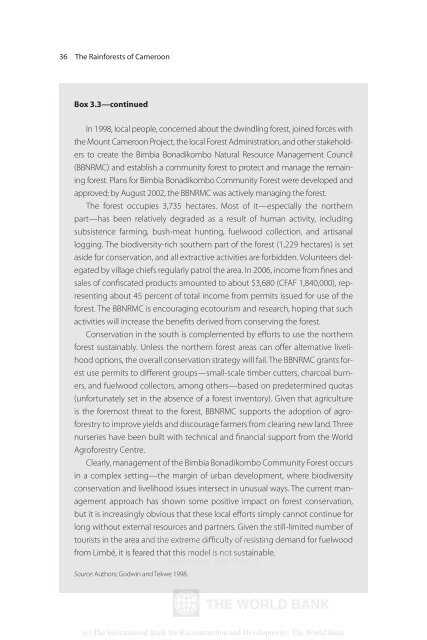The Rainforests of Cameroon - PROFOR
The Rainforests of Cameroon - PROFOR
The Rainforests of Cameroon - PROFOR
- No tags were found...
Create successful ePaper yourself
Turn your PDF publications into a flip-book with our unique Google optimized e-Paper software.
36 <strong>The</strong> <strong>Rainforests</strong> <strong>of</strong> <strong>Cameroon</strong>Box 3.3 —continuedIn 1998, local people, concerned about the dwindling forest, joined forces withthe Mount <strong>Cameroon</strong> Project, the local Forest Administration, and other stakeholdersto create the Bimbia Bonadikombo Natural Resource Management Council(BBNRMC) and establish a community forest to protect and manage the remainingforest. Plans for Bimbia Bonadikombo Community Forest were developed andapproved; by August 2002, the BBNRMC was actively managing the forest.<strong>The</strong> forest occupies 3,735 hectares. Most <strong>of</strong> it—especially the northernpart—has been relatively degraded as a result <strong>of</strong> human activity, includingsubsistence farming, bush-meat hunting, fuelwood collection, and artisanallogging. <strong>The</strong> biodiversity-rich southern part <strong>of</strong> the forest (1,229 hectares) is setaside for conservation, and all extractive activities are forbidden. Volunteers delegatedby village chiefs regularly patrol the area. In 2006, income from fines andsales <strong>of</strong> confiscated products amounted to about $3,680 (CFAF 1,840,000), representingabout 45 percent <strong>of</strong> total income from permits issued for use <strong>of</strong> theforest. <strong>The</strong> BBNRMC is encouraging ecotourism and research, hoping that suchactivities will increase the benefits derived from conserving the forest.Conservation in the south is complemented by efforts to use the northernforest sustainably. Unless the northern forest areas can <strong>of</strong>fer alternative livelihoodoptions, the overall conservation strategy will fail. <strong>The</strong> BBNRMC grants forestuse permits to different groups—small-scale timber cutters, charcoal burners,and fuelwood collectors, among others—based on predetermined quotas(unfortunately set in the absence <strong>of</strong> a forest inventory). Given that agricultureis the foremost threat to the forest, BBNRMC supports the adoption <strong>of</strong> agr<strong>of</strong>orestryto improve yields and discourage farmers from clearing new land. Threenurseries have been built with technical and financial support from the WorldAgr<strong>of</strong>orestry Centre.Clearly, management <strong>of</strong> the Bimbia Bonadikombo Community Forest occursin a complex setting—the margin <strong>of</strong> urban development, where biodiversityconservation and livelihood issues intersect in unusual ways. <strong>The</strong> current managementapproach has shown some positive impact on forest conservation,but it is increasingly obvious that these local efforts simply cannot continue forlong without external resources and partners. Given the still-limited number <strong>of</strong>tourists in the area and Delivered the extreme by <strong>The</strong> difficulty World Bank <strong>of</strong> e-library resisting to: demand for fuelwood<strong>The</strong> World Bankfrom Limbé, it is feared that this IP model : 192.86.100.34 is not sustainable.Mon, 09 Nov 2009 17:06:18Source: Authors; Godwin and Tekwe 1998.(c) <strong>The</strong> International Bank for Reconstruction and Development / <strong>The</strong> World Bank
















